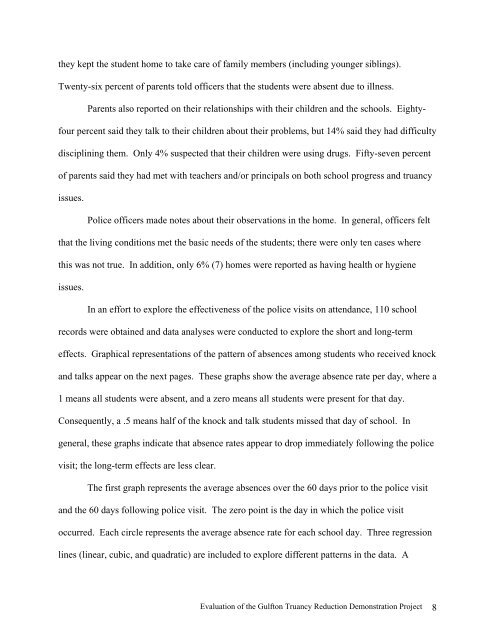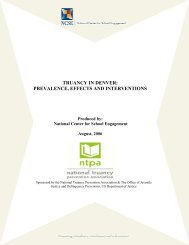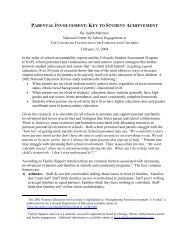Gulfton Truancy Reduction Demonstration Project, Houston, TX
Gulfton Truancy Reduction Demonstration Project, Houston, TX
Gulfton Truancy Reduction Demonstration Project, Houston, TX
Create successful ePaper yourself
Turn your PDF publications into a flip-book with our unique Google optimized e-Paper software.
they kept the student home to take care of family members (including younger siblings).<br />
Twenty-six percent of parents told officers that the students were absent due to illness.<br />
Parents also reported on their relationships with their children and the schools. Eightyfour<br />
percent said they talk to their children about their problems, but 14% said they had difficulty<br />
disciplining them. Only 4% suspected that their children were using drugs. Fifty-seven percent<br />
of parents said they had met with teachers and/or principals on both school progress and truancy<br />
issues.<br />
Police officers made notes about their observations in the home. In general, officers felt<br />
that the living conditions met the basic needs of the students; there were only ten cases where<br />
this was not true. In addition, only 6% (7) homes were reported as having health or hygiene<br />
issues.<br />
In an effort to explore the effectiveness of the police visits on attendance, 110 school<br />
records were obtained and data analyses were conducted to explore the short and long-term<br />
effects. Graphical representations of the pattern of absences among students who received knock<br />
and talks appear on the next pages. These graphs show the average absence rate per day, where a<br />
1 means all students were absent, and a zero means all students were present for that day.<br />
Consequently, a .5 means half of the knock and talk students missed that day of school. In<br />
general, these graphs indicate that absence rates appear to drop immediately following the police<br />
visit; the long-term effects are less clear.<br />
The first graph represents the average absences over the 60 days prior to the police visit<br />
and the 60 days following police visit. The zero point is the day in which the police visit<br />
occurred. Each circle represents the average absence rate for each school day. Three regression<br />
lines (linear, cubic, and quadratic) are included to explore different patterns in the data. A<br />
Evaluation of the <strong>Gulfton</strong> <strong>Truancy</strong> <strong>Reduction</strong> <strong>Demonstration</strong> <strong>Project</strong> 8










